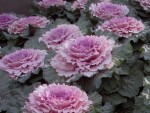 Cool temperatures provide a great opportunity for planting some beauties that will not thrive during warmer times so when October arrives I head for the local farmers’ market where I can find a nice selection of ornamental cabbage and kale. They need cool temperatures to develop the fabulous colors they boast, so some years their appearance in the market is later than in other years; the weather is the all important factor. The colors that can develop along with the green leaves are white, pink, red, and purple, making them a colorful addition to any garden or container in fall. In general, the centers of those with white leaves in the middle will succumb to cold weather and rains by turning brown.
Cool temperatures provide a great opportunity for planting some beauties that will not thrive during warmer times so when October arrives I head for the local farmers’ market where I can find a nice selection of ornamental cabbage and kale. They need cool temperatures to develop the fabulous colors they boast, so some years their appearance in the market is later than in other years; the weather is the all important factor. The colors that can develop along with the green leaves are white, pink, red, and purple, making them a colorful addition to any garden or container in fall. In general, the centers of those with white leaves in the middle will succumb to cold weather and rains by turning brown. 
There are two kinds: those with heads, like cabbages, and those that produce their leaves in clusters, like kale. Either kind can have large rounded leaves and/or finely dissected ones. In general, the head-forming types will sent up flowers a few weeks earlier than the leafy kale types and thus end their usefulness in the garden earlier. This process is called bolting and can occur anytime that temperatures warm up. Some people like the flowers and so the time of bolting is not important but most people grow the plants for their colorful leaves.
Another threat to the beauty of ornamental cabbage and kale is sudden cold spells. Although the plants can survive several light frosts, and, in fact, some cold temperatures if they have been slowly acclimatized, they will usually turn to mush when temperatures get into the teens. There is nothing you can do to help the plants slowly adjust to cold temperatures so be aware of the problem and fix it if you have to.
Some final words ornamental cabbage or kale of any kind. Growing them from seed is very tricky because the pest and disease problem is enormous and the temperatures can cause them to bolt prematurely. When buying potted plants, buy the size you need because pot bound plants will not increase in size. I learned the hard way last year when I bought a 9-pack at a great price and thought I would plant them out and let them grow to full size but no, they stayed petite. They were not the bargain I had hoped but pretty all the same.
Type: Cool weather biennial.
Bloom: Grown primarily for colorful foliage, white, pink, mauve, red, purple.
Size: 1-3’ H x 1-3’ W.
Light: Full sun.
Soil: Fertile, moist, well drained.
Pests and Diseases: A variety of pests and diseases can infect young plants but are usually eliminated by cool temperatures.
Propagation: Seed.
Companion plants: Pansies, curly parsley, ornamental chard, colorful lettuce such as chicory ‘Rossana’ (dark wine leaves with white midrib).
Outstanding Selections: Feather series( kale-type), Peacock series (kale-type), Tokyo series (cabbage-type).
